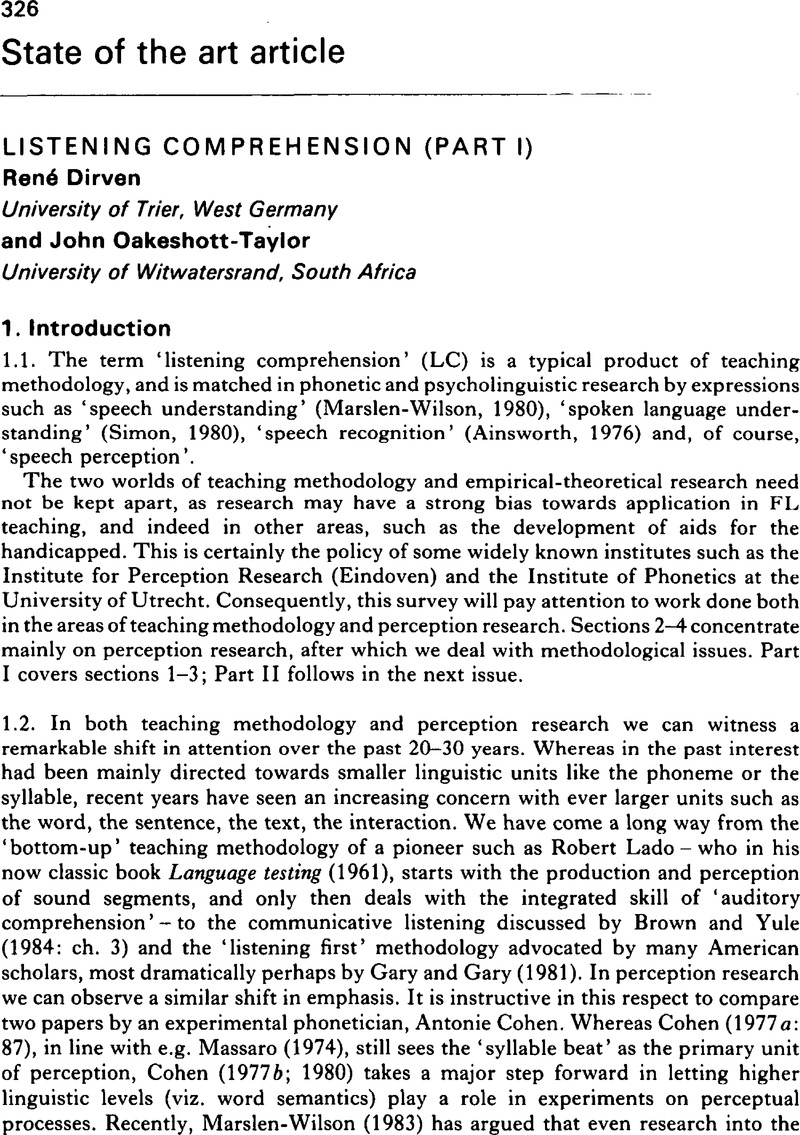Crossref Citations
This article has been cited by the following publications. This list is generated based on data provided by Crossref.
Dirven, René
1985.
Definition of a Pedagogical Grammar.
ITL - International Journal of Applied Linguistics,
Vol. 67-68,
Issue. ,
p.
43.
Oakeshott-Taylor, John
1986.
Slips of the ear.
System,
Vol. 14,
Issue. 1,
p.
99.
Carter, Ronald
1987.
Vocabulary and second/foreign language teaching.
Language Teaching,
Vol. 20,
Issue. 1,
p.
3.
DICKERSON, WAYNE B.
1987.
Orthography as a pronunciation resource.
World Englishes,
Vol. 6,
Issue. 1,
p.
11.
Pennington, Martha C.
1989.
Teaching Proununciation from the Top Down.
RELC Journal,
Vol. 20,
Issue. 1,
p.
20.
Trammell, Robert L.
1993.
English Ambisyllabic Consonants and Half‐Closed Syllables in Language Teaching.
Language Learning,
Vol. 43,
Issue. 2,
p.
195.
RUBIN, JOAN
1994.
A Review of Second Language Listening Comprehension Research.
The Modern Language Journal,
Vol. 78,
Issue. 2,
p.
199.
Buck, Gary
1994.
The appropriacy of psychometric measurement models for testing second language listening comprehension.
Language Testing,
Vol. 11,
Issue. 2,
p.
145.
Munro, Murray J.
1995.
Nonsegmental Factors in Foreign Accent.
Studies in Second Language Acquisition,
Vol. 17,
Issue. 1,
p.
17.
Hewings, Martin
1995.
The English Intonation of Native Speakers and Indonesian Learners: a Coniparative Study.
RELC Journal,
Vol. 26,
Issue. 1,
p.
27.
Lee, Philip Yungkin
1995.
Some examples of listening exercises in Mandarin.
Australian Review of Applied Linguistics. Series S,
Vol. 12,
Issue. ,
p.
229.
Buck, Gary
1997.
Encyclopedia of Language and Education.
p.
65.
Goh, Christine
2005.
Expertise in Second Language Learning and Teaching.
p.
64.
Champagne-Muzar, Cécile
2009.
Le rôle des faits phonétiques dans le décodage perceptif en langue seconde : état de la question.
Revue québécoise de linguistique,
Vol. 21,
Issue. 1,
p.
41.
Flowerdew, John
and
Miller, Lindsay
2010.
Listening and Human Communication in the 21st Century.
p.
158.
Seung-Jae Moon
and
Ho Han
2013.
A Study on the Improvement of English Speaking Skills Through Tracking.
The Jungang Journal of English Language and Literature,
Vol. 55,
Issue. 2,
p.
73.
Tergujeff, Elina
2015.
Teaching and Researching the Pronunciation of English.
p.
107.
Alcaraz-Valencia, Pablo A.
Gaytán-Lugo, Laura S.
and
Gallardo, Sara C. Hernández
2018.
Optimizing Human-Computer Interaction With Emerging Technologies.
p.
306.
Pennington, Martha C
2021.
Teaching Pronunciation: The State of the Art 2021.
RELC Journal,
Vol. 52,
Issue. 1,
p.
3.
Westbrook, Carolyn
2023.
The impact of input format on written performance in a listening-into-writing assessment.
Journal of English for Academic Purposes,
Vol. 61,
Issue. ,
p.
101190.





